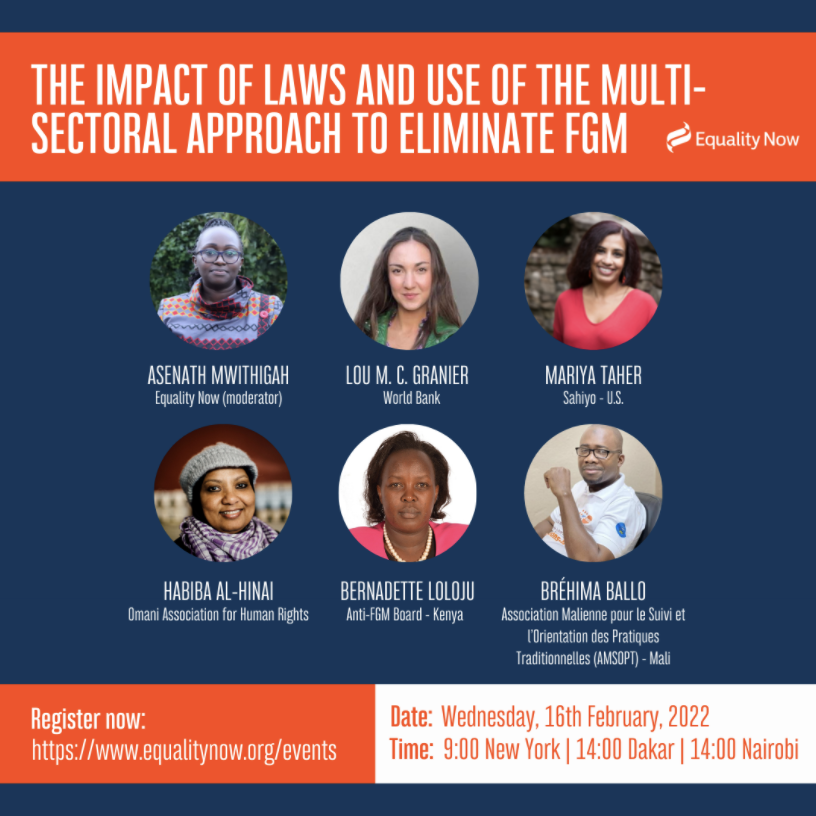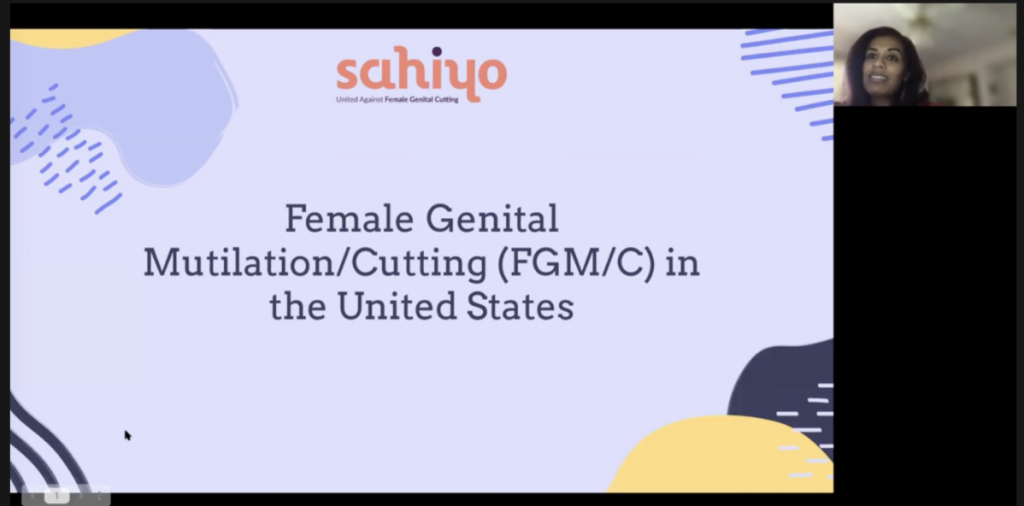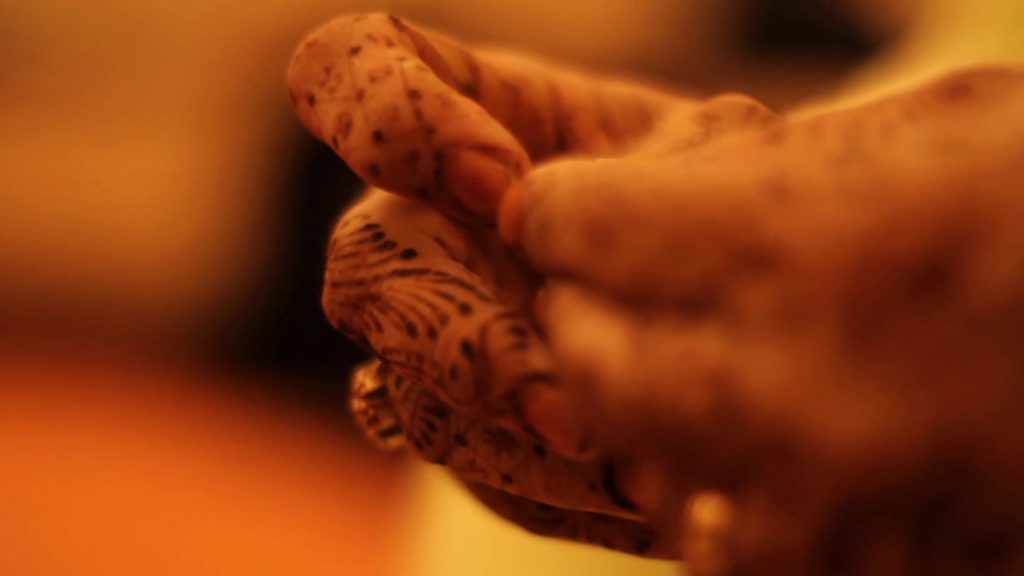Training the Virginia Department of Criminal Justice on how to support survivors of FGM/C

On August 8th, Sahiyo hosted a training for the Virginia Department of Criminal Justice, titled “Cross-Collaborative Work: Incorporating Female Genital Mutilation/Cutting Survivors into Support Services in Virginia.” Even with growing recognition of FGC in the U.S., many service-providers, including law enforcement, are not adequately equipped to address FGC in the United States. This training provided an introductory foundation for an understanding of FGC, as well as the role the legal system and victims advocates have in addressing and responding to this issue. In addition, the training addressed key competencies and best practices for working with and interacting with survivors of FGC and/or practicing communities. This training was attended by 60+ members of the Virginia Department of Criminal Justice Services, including victims advocates, researchers, law enforcement, legal services, healthcare providers, and others.
Sahiyo speaks at the ABA International Law Section Annual Conference

On April 28th, Sahiyo was invited to take part in a panel discussion at the 2022 ABA International Law Section’s Annual Conference being held in Washington D.C. The panel brought together a legal practitioner, journalist, and activist working towards gender equality and the elimination of FGC to discuss legal tools and other measures that have been adopted to end this practice worldwide. Program Chair: Sandrine Siewe, Georgetown Law, Washington, DC Moderator: Bayor Chantal Ngoltoingar, Anti FGM Advocate Speakers: Isabella Micali Drossos, Senior Counsel, World Bank Shelby Quast, Robertson, Quast & Associates, US End FGM/C Network Giselle Portenier, Journalist, End FGM Canada Network Mariya Taher, Cofounder, Sahiyo, US End FGM/C Network During the event, speakers introduced the World Bank’s Fifth edition of the Compendium of International and National Legal Frameworks. The speakers also highlighted Federal- and state-level policy and law around FGC in the United States, and spoke to measures and programs that can help those impacted by FGC recover from the harms caused by this practice. Moreover, the panelists discussed the role of a bottom-up-oriented strategy, such as active and intergenerational dialogues within communities, for finding solutions to end FGC.
A reflection on Equality Now’s webinar: The impact of laws and use of Multi-Sectoral Approach (MSA) to eliminate FGM/C

By Ellen Ince I joined Equality Now and women’s rights activists, survivors, and human rights practitioners for a discussion on the importance and roles of both law and multi-sectoral approach (MSA) in the elimination of Female Genital Mutiliation/Cutting (FGM/C). This event took place on February 16th, 2022 and was moderated by Asenath Mwithigah. Interpretation was provided in English, French and Arabic. How can not only protect, but advance the rights of women around the world? FGM/C is a form of discrimination that has life long affects. It directly impacts a woman’s right to dignity, right to life, freedom from torture and inhuman treatment, freedom from discrimination based on gender, and right to the highest attainable health among other rights. Ending FGM/C can be done through advocacy and law, with the two going hand in hand. While many think that FGM/C is only practiced in Africa, a recent study by Equality Now (in collaboration with the US End FGM/C Network and The European FGM Network) found that FGM/C is carried out in 92 countries. This makes it a global issue that requires a co-ordinated multi-sectoral approach. Of these 92 coutnries where it is practised, only 51 have specifically addressed issues of FGM/C in law. Are laws alone enough? Worldwide 68 million women and girls will be at risk of FGM/C by the year 2030 if the current levels of intervention as they are remain in place. As trends are globally changing, so too is the issue itself. As a social norm that does not respect geographic boundaries, FGM/C has filtered into Europe and spread to non-practising countries through migration. This has resulted in FGM affecting every continent. Speakers underlined that interventions need to be holistic and integrate a multi-sectoral approach to be able to address these emerging issues. Law sets the standard of what is morally acceptable behaviour. The absence of anti-FGM/C law therefore poses a threat to our efforts to combat the issue. FGM/C challenges the core foundations of human rights and breaches the universal standard of what is morally correct. Laws prohibiting FGM/C have a powerful impact in eliminating the practise. Time to change challenges into opportunities. Caroline Lagat stated that although FGM/C is a national priority in many countries, only a handful allocate a budget towards the realisation of their anti-FGM/C strategies or in fact the implementation of programmes targeting to end FGM/C. This point made me realise that the presence of law alone is not enough. Financial resources are essential in the proper implementation of these laws. Caroline stressed that the commitment to end FGM/C also needs to come in the form of financial investment. The event featured panellist Mariya Taher, who since 2015 has collaborated with the Women’s Bar Association of Massachusetts to pass legislation to protect girls from FGC. Mariya has been an instrumental advocate and expert in ending FGC. She spoke about the need to cover vacation cutting under state law and gave a brief history of FGM/C federal law. In 1996 the US passed a federal law making FGM/C illegal. This law was amended in 2013 to include a travel provision. Mariya explained the success of this law as it closes the loophole that previously existed that allowed for girls to be taken out of the country to have FGM/C performed on them. Mariya agreed that law can be used as a tool to discourage the practice and that this justifies the need for funding. FGM/C is a crime. It is important how we frame it. Lou Granier, a French international consultant in development specialising in gender, has specifically dedicated to work towards the eradication of FGM/C and has been working with the world bank and numerous NGO’S. Lou made it clear that every country in the world has a law on FGM/C. The law may not specifically target FGM/C but every jurisdiction provides protection against harm and torture. She explains that France for example does not have a specific FGM/C law. FGM/C, however remains illegal in France. Lou pointed out that using general laws to protect women from FGM is good strategy to consider. She did state that specific FGM/C laws are important because they specifically define and criminalises it, leaving no room for vagueness and further protecting women from legal discrimination. The work against FGM goes further than borders. Madame Bernadette Loloju, a passionate girls rights crusader committed to ending the practice of FGM/C in Kenya also spoke about cross border FGM/C as a challenge. She accurately framed this challenge as ‘people running away from the law’. This demonstrates that law can only stretch so far and that people are going behind the law. Even with law in place we need other strategies in place to end FGM/C. A multi sectoral approach may provide the answer whilst saving on resources such as time. This approach also allows for more collaboration and teamwork. FGM – a tradition wrapped in extreme secrecy. Human rights defender, Habiba Al-Hinai, discussed the power of individuals and activists. This is especially prevalent in citations where the government is silent or inactive. The government can provide a law but law has a limited impact. It is the people that can create change by acting as advocates and adding pressure. Ballo Bréhima, a program manager of an NGO in Mali states that law teaches communities that FGM/C is harmful and not good for the health of young girls and women. Education surrounding FGM/C is crucial as someone who is aware of the inequalities of this practice will not cut their daughters. It is also important to change the minds of those who underwent FGM/C themselves. Mariya highlighted that survivors can also be the voices for their own daughters. An important point I took away from this webinar is that with FGM/C, the problem is not that the law does not condone it, but that the culture in which it occurs reinforces it. The panel discussion followed by a question and answer session led by Paleki Ayang. I particularly
Sahiyo partners with FAWCO to lead an educational webinar on Female Genital Mutilation/Cutting in the United States

By Beth Fotheringham On the 16th of September, the FAWCO Target Team collaborated with Sahiyo for an educational webinar about FGM/C in the United States. The webinar sought to highlight the essential work Sahiyo does in their work to end FGC and support survivors. At the start of the webinar, Sahiyo co-founder and U.S. Executive Director Mariya Taher provided context with her own expertise on both ‘khatna’ and the Dawoodi Bohras, a community that partakes in the harmful practice of FGM/C. Through her own journey of speaking out as a survivor, she recognised the need for an organised forum within practicing communities, as well as the individual and collective benefits of creating positive social change through empowerment. It was evident that this had informed Sahiyo’s own unique approach to supporting survivors and raising awareness, which centres on storytelling. Mariya proceeded to clarify the various terminologies used in talking about female genital cutting (FGC), as well as the different types of the practice; she deftly outlined why Sahiyo uses ‘cutting’ instead of ‘mutilation,’ while respecting the right of survivors to choose how to define and describe their own experiences. She unflinchingly laid out the fact that 500,000+ women and girls are estimated to be living with, or at risk of, FGM/C in the US. This was especially shocking for me to learn, due to so much of the discourse surrounding FGC focusing on cases in Africa or “developing” countries, and evidence of such practices being greatly underreported in the Western world. This figure was made even more impactful when Mariya further deconstructed the statistic. She posited that this is most likely an under-representation, as it does not include any diasporic communities from countries not included within the 32 countries studied by UNICEF. For example, the Bohra community, who do practice FGC, are not counted in this statistic, nor are most other Asian countries where evidence of FGC exists. The most recent study into FGC prevalence found evidence of FGC in 92 countries worldwide, strongly suggesting that the statistic from the United States is a considerable underestimate. Through the webinar, we learned that there are current efforts within the US by the Center for Disease Control and Prevent (CDC) to capture more accurate data, which sounded promising, but that data collection is in its early stages. In another part of the webinar, various survivor stories from the Voices to End FGC project were introduced. Renee Bergstrom’s story was particularly powerful in addressing and disrupting common misconceptions about where FGC takes place and to whom. Jenny’s story portrayed the devastating silence that upholds the practice happening generation after generation; Maryah Haidery’s story explored the various psychological consequences of FGC. All were both informative and inspiring. Mariya also spoke on the legal context of FGC in the United States, explaining and analysing the current federal legislation, while applying it to real legal cases. This was especially helpful to understand — as someone who lives outside of the US I find the state/federal separation particularly confusing — and it became much clearer how abuses of human rights, such as FGC, are able to slip through the gaps of the law. After watching the webinar, I found it indisputably apparent that there are neither sufficient federal nor state laws to effectively uphold the work against FGC in the United States, and absolutely appalling that not even every state has legislation against the practice (with only 6/7 states having comprehensive laws against FGC). Though I understand that criminalisation of FGC is by no means the only, or most effective, way of ending the practice, I think it is important in taking a clear (and sometimes symbolic) stance against FGC with coherent legislation that automatically supports the work of activists and survivors to stop FGC in different countries. Alongside this, it also helps families who are doubtful of the benefits of FGC for their daughters have a legitimate reason not to carry out the procedure while not having to outright stand against the rules of their cultures and communities. I found it especially inspiring to hear from Mariya how Sahiyo’s work has been instrumental in passing state laws; most recently, and successfully, in Massachusetts. Sahiyo is now engaged in similar work to pass a state law in Connecticut, one of the ten remaining states without any legal protections against FGC whatsoever. I think focusing on the progress that has been made definitely provides effective encouragement to keep working for change. It was similarly uplifting to learn that the Voices Projects have resulted in survivors feeling a sense of empowerment and a surge of desire for collective action, as well as experiencing a strong sense of comradery with other storytellers. This embodies what inspires and impresses me most about Sahiyo: not only are they doing crucial work to end FGC and stop future generations of girls, women and others from having to undergo the practice, but they also have an important focus on supporting those that have already been through it. Listening to the stories of these survivors conveys clearly how successful this parallelled approach is. Interestingly, in Sahiyo’s study of 400 Dawoodi Bohra women, which found that 80% of the women had been cut, 81% also said that they didn’t want the practice to continue into the next generation. FGC is a social norm that has been justified, with silence being a key part of why it has continued. I now understand how telling these stories breaks the silence and takes the conversation out of hidden, private spheres and into the public one. Mariya spoke of particularly relevant research that found when it comes to social norms and culture change, if 25% of a community changes or adopts a new norm, then it becomes wide scale enough for permanent change to occur. Mariya concluded her talk by discussing Sahiyo’s various other programs, such as Thaal Pe Charcha, Bhaiyo, Sahiyo Activist Retreat, and Community Education and Outreach, all of which have had substantial success in supporting FGC survivors
Sahiyo’s statement on the Michigan case dismissal on Sep 28, 2021

It is with great sadness and disappointment that Sahiyo responds to the recent judgement in the Michigan case. Female genital cutting (FGC) is recognized internationally, and specifically by the U.S. Government as a violation of human rights. Judge Friedman’s decision to throw out this case, which is the nation’s first FGC case, highlights a failure to protect girls in the United States from this harmful practice, and a failure to truly understand the extent and pervasiveness of FGC within this country. (See the Amicus Brief, which is informed by survivors of the same community as the girls in this case, and provides details on these aspects of FGC for the judge). This judgment has been met by much criticism already, with a call from The US End FGM/C Network for more training across all branches of government, including judicial training that includes: what FGM/C is, how it is carried out, and its life-long impact on women and girls. Sahiyo believes we cannot allow harmful practices such as FGC to continue. Girls’ rights cannot go unprotected due to legal technicalities and decisions made by those who do not, or refuse to, understand the realities of gender-based violence. We must all work together to protect ALL girls from this harm and we call on the Department of Justice to appeal this decision. Background on the case On April 13, 2017, Detroit emergency room doctor Jumana Nargarwala was arrested and charged with performing FGC on minor girls in the United States. This was the first time someone was brought up on charges under 18 U.S.C. 116, which criminalizes FGC. According to the U.S. Federal complaint, Dr. Nagarwala performed FGC on 6 to 8 year old girls out of a medical office in Livonia, Michigan. Some of these girls’ families reportedly traveled inter-state to have the doctor perform FGC. On November 20, 2018, Judge Bernard Friedman ruled that the US Federal Law banning Female Genital Cutting was unconstitutional based on a technicality. With this ruling, the judge dismissed key charges of FGC against two Michigan doctors and six other people accused of practicing genital cutting on several minor girls. The ruling was determined by Judge Friedman’s stance that the crime of FGC should be regulated by individual states. However, the US does not actually have laws against FGC in every single state. At the time, only 27 out of 50 states had a state law banning FGC. As of October 2021, there are now 40 states with a state law. There is a state law in Michigan banning FGC, but the law only came into effect in 2017 after the federal case involving Dr. Nagarwala and Dr. Attar came to light. The doctors cannot be prosecuted retrospectively under this Michigan state law. After Judge Friedman’s verdict in 2018, the Department of Justice failed to appeal Judge Friedman’s decisions in 2019. As a result, Congress filed a motion to appeal the decision, but the motion was denied. In 2020, these events led Congress to unanimously amend and strengthen the Federal FGC law, in order to withstand future challenges, while firmly stating its disagreement with Judge Freidman’s interpretation of the law. In January of 2021, Congress passed the H.R. 6100-STOP FGM Act. (((To learn more about the history of this court case and legislation in the U.S., read CoP Law & FGM – Legislation in North America.) However, the combination of Judge Friedman’s recent decision in September 2021 dismissing the remaining charges against Doctor Nargarwala (and calling the prosecution ‘vindictive’ for seeking new charges), with the Department of Justice’s original decision in 2019 to not appeal his decision, underscores how protecting girls from violence was not central to the case.
Absence of female genital cutting laws in India: An issue that requires immediate action

By Richa Bhargava Age: 20 Country: India As a first year law student in Sonipat, India, I was exposed to the practice of female genital cutting (FGC) as a part of my sociology course. We discussed the practice briefly. The article that formed a majority of our discussion only spoke of the existence of FGC in African nations and made no mention of India or other countries around the world where women are subjected to the practice. I felt shocked and truly disturbed when I first learned about FGC, and as a result, my response was to read about it on my own accord. A little browsing led me to the discovery of the fact that FGC prevails in the Indian subcontinent as well. I read about the Bohra community, the absence of legislation and the organisations and people advocating to end this harmful and unnecessary practice. Laws do not just force and punish. They deter, discourage and dissuade, too. Enacting and legislating laws raises awareness and empowers communities to change not only what people do, but what they think is right. It is vital for laws to continuously evolve with the changing norms and ideals of a society. FGC is a prevalent practice among the Bohra community in India. A study indicated that almost 75% of the women of this community who were interviewed have been cut. At present, many citizens are unaware of its presence in India. Lifting the veil off this practice is an essential step toward ensuring that a conversation regarding its harmful effects on young girls begins. Maneka Gandhi, a union minister, stated that there is a lack of proof regarding the existence of FGC in India, and there is no data to support its presence. The Ministry of Women and Child Development needs to conduct surveys and take appropriate measures to find all data that would make the legislators see the need for the enactment of a law against FGC. To avoid addressing the issue is to completely ignore its existence. A similar approach has been taken up by the Indian government over the years. Multiple accounts of women who have undergone FGC are out in the public domain and provide substantial evidence to prove the presence of khatna, as it is known in the Bohra community. Yet, no legislation or statute has been formulated or enacted in India which would help survivors find an easy legal recourse. There is an imperative need to move beyond the pretext of not having enough data to prove FGC occurs in India. Hundreds of survivors have spoken up against this practice and have openly shared their painful accounts. Many survivors have shared that since khatna is secretive, making it unlawful could have a serious impact in curtailing it. According to Section 320 and Section 322 of the Indian Penal Code, causing grievous hurt to another person is a criminal offence, and FGC would automatically fall within its purview. Despite this, there has been no effort on the part of the legislators to specifically provide remedy to survivors. The Indian Constitution guarantees the fundamental right to life and liberty to all its citizens. Legal statutes like the Indian Penal Code and the Prevention of Children from Sexual Offences (POCSO) Act that penalise crimes should mention terms such as female genital mutilation/cutting, labia minora, etc., to provide appropriate legal recourse to women affected by this practice. India claims to be a welfare state that ensures the well-being of all its citizens. Refusing to ensure the safety of young girls who might be subjected to FGC is a contradictory act. Various jurists and legislators face the problem of deciding whether one fundamental right should be given more importance than the other. The proposed ban on khatna raises a similar obstacle. The Indian Constitution confers upon its citizens the right to equality, as well as the right to practice and profess any religion. There exists a constant clash between articles 14 and 15 defining right to equality and articles 25 and 26 defining religious rights. In particular, the rights guaranteed to people under article 26 pose a unique challenge before the courts. In recent years, courts have come to realise that the right to equality should be awarded more weight. Discrimination solely on the basis of one’s gender is highly dishonourable and unjust. In order to move forward, a distinction between social malpractices and actual religious practices needs to be made. Social norms disguised as religious practices infringing upon the rights of women need to be done away with. The right and autonomy over one’s body is crucial to live a respectful life. People frequently wonder whether legislation can bring about change. Fear that criminalising FGC might result in a deeper continuation of it is felt by many and is a valid concern. However, often the notion that a new law can elevate conversation on FGC and create a discourse for all to engage in on the topic is overlooked. The existence and continuity of khatna cannot just be attributed to the fault of a community. With democratic ideals such as equality and freedom, the state cannot shy away from establishing and constituting laws that are in symmetry with these ideals.
Understanding female genital mutilation/cutting: An ally’s call for action

By: Farhanaz Hazari Age: 18 My fight against female genital mutilation/cutting (FGM/C) can be traced back to the day my mother and sister had a discussion with me on how young girls from the age of 7 are subjected to FGM/C or khatna, as it is known in the Bohra community. They explained it in simple terms, as I was still in school and unfamiliar with the practice, and guided me on how to approach the subject. They educated me on who conducts this act and where it is conducted and for what reasons. They told me that it was taboo to talk about it freely and also to never ask if anyone had been subjected to khatna. After hearing this from two people that are close to my heart, I trusted their word and never asked anyone about it. I had no idea little girls were subjected to such pain and trauma. They are children, after all. Aren’t they supposed to play with dolls and fight for the window seat on the bus ride home? Why are people insisting on controlling girls from such a young age? Why are they putting them through this mental trauma? Why isn’t anyone speaking up against it? All these questions were flooding my mind and all I wanted was someone to tell me this isn’t happening anymore. To think I was hurt and frustrated would be an understatement. I was angry and sad at the same time. I thought this is a tradition that had been shunned and looked down upon by many communities around the world. But to my misery that was not the reality. The next time I came across the word khatna in one of the books in The Princess Trilogy by Jean Sasson, it brought me to tears. At that point I knew I had to do something to raise awareness against it or simply make it known to people that it is a violation of a girl’s body. I read up about female genital mutilation/cutting and learned about how its roots were traced back to Egypt. I learned about the four types and how there is no scientific evidence to help women medically in any way. Being a student of law, I have the opportunity to speak up and back my reasoning with legal knowledge. FGM/C infringes upon the girl child’s human rights, such as the right to bodily autonomy, equality, right to life and personal liberty, which includes the right to be free from any form of violence. After the young girls are cut, they may die, or bleed continuously and/or develop an infection, which violates their right to have a healthy life under Article 21 of the Constitution of India. Justice Chandrachud also stated, “One has supreme authority over genitalia. It is central to one’s identity, dignity and autonomy.” The recognition of the harms of FGM/C is increasing day by day as many are filing petitions, raising their voices and sharing their stories with the help of nongovernmental organizations. I have the opportunity to voice my thoughts against the practice with the help of Sahiyo, and for that I am eternally grateful. The Pakistani activist Malala Yousafzai said, “There’s a moment when you have to choose whether to be silent or to stand up.” I say stand up. Raise your voice and help put an end to FGM/C.
The United States has a law banning female genital cutting. What now?

By Hunter Kessous On January 5th, the H.R. 6100-STOP FGM Act was signed into law, upon being passed through the House of Representatives and the Senate unanimously. The federal law criminalizes female genital cutting (FGC), a form of gender-based violence against young girls, which involves medically unnecessary partial or total removal of the external genitalia. According to the Centers for Disease Control, over 500,000 girls and women have undergone or are at risk of undergoing FGC in the United States alone. Globally, that number rises up to 3 million girls at risk per year, with a total of over 200 million girls and women having been cut. The STOP FGM Act strengthens the opposition to FGC by stating that religious or cultural beliefs may not be used in defense of the practice. Additionally, government agencies, such as the Departments of Education and Justice, will be required to report to Congress on the estimated number of women and girls who have undergone or are at risk of FGC in the U.S., and on efforts to prevent the practice. They will also give a report on the actions they take toward educating the community and preventing FGC from continuing. Advocates and policymakers have been working toward this goal for so long that it was concerning when the new law didn’t garner a lot of media attention. This could be because the U.S. has technically had a law against FGC since 1996—emphasis on technically, because for the past two years, the Department of Justice has refused to enforce the law. The only intact portion of the law has been a ban on taking a minor out of the U.S. to be cut, a practice known as vacation cutting. In 2018, a Michigan doctor was taken to court for the mutilation of over 100 girls. The judge dismissed the charges and ruled that Congress did not have the authority to pass the FGC law by associating it with the Commerce Clause, claiming that there is nothing “commercial or economic” about FGC. The STOP FGM law clarifies that FGC is, in fact, linked to inter-state or foreign commerce, thereby confirming Congress’ power to make FGC illegal. Since that pivotal case over two years ago, young girls are now protected against FGC under federal law. Although there is reason to celebrate, activists aren’t putting their feet up anytime soon. As far as policy goes, there is still more work to do. Despite the federal law, state laws against FGC are a necessary tool. Federal and state laws each protect girls in different ways. The federal law against FGC will be put to use if the crime involves interstate activity, such as transporting a girl to another state to be cut. We need state laws against FGC to protect girls in cases of local criminal activity, as was recommended by the judge in the aforementioned Michigan court case. To date, there are still 11 states which do not have any laws against FGC. In the states that do have anti-FGC policies, action must be taken to make these laws more comprehensive. Several states do not clarify that cultural/ritual reasons and alleged consent may not be used as a defense for performing FGC on a minor. Few states have legislation which includes a provision for community education and outreach, which is a key component of prevention. In addition to improving state laws, even more can be done at the federal level. Policy from the Department of Education and Health and Human Services requiring FGC education in schools can go a long way toward prevention. “While we celebrate the signing of H.R. 6100 and the recent Massachusetts law, we must continue to advocate for not only the criminalization of FGM/C, but a Federal Education Law,” said Angela Peabody, founder of the Global Woman P.E.A.C.E Foundation and political lobbyist. “It is imperative for every child in the United States to be knowledgeable about the practice of FGM/C. Even though several states have included an education clause in their laws, a federal law would cover all states. The schools already teach Family Life Education; therefore including the study of FGM/C in the FLE curriculum is not a difficult task. Virginia is already in the process of doing that.” Virginia has incorporated education about FGC into their school curriculum for middle and high schoolers in which they learn “the dangers of FGC, the criminal penalties, and the rights of the victim.” Education such as this serves to increase awareness, put an end to the thinking that FGC is not an American issue, and give a voice to the next generation of activists. The current law criminalizes FGC, and calls on several government agencies to enact programs that will protect girls and create public awareness. The law left the guidelines for these agencies vague, which leaves room for experts and advocates to guide these departments. There are many ways, for example, that policy can support girls and women living in the U.S. who have already undergone FGC, or those who will be cut in spite of the new law. Survivors face a range of physical and psychological complications. These include, but are not limited to, infection, fistulas, birth complication, sexual dysfunction, and post-traumatic stress disorder. Policy could go a long way to alleviate these burdens. For example, survivors of domestic violence are permitted to enroll in an ACA healthcare plan at any point during the year, rather than just during the open enrollment window. A policy such as this being applied to FGC survivors and their dependents would be a great step toward increasing access to healthcare. Yet, many of the less expensive healthcare plans do not provide counseling services, and this may not be apparent until after the plan has been purchased. Therefore, another area where legislation could protect FGC survivors is by creating federally funded programs to provide needed health care services, which may be lacking from their current healthcare plan, at subsidized rates or at no cost. There was
Texas woman charged for Female Genital Cutting: Sahiyo press statement

A woman from Houston, Texas (USA) has been charged under federal United States’ law for transporting a minor out of the country for the purpose of Female Genital Mutilation/Cutting (FGM/C). According to the Federal Bureau of Investigation (FBI) which is investigating this case, the 39-year-old woman allegedly transported the child sometime between July 10 to October 14, 2016. This is the first time that the US Department of Justice has indicted anyone under this specific clause of the US anti-FGM/C law, i.e, transporting a minor girl outside of US borders to facilitate the practice of genital cutting. While FGM/C has been illegal in the United States since 1996, this clause was introduced in 2013. The FBI is investigating the case with the support of the Human Rights Violators and War Crimes Center, a government agency that works to identify, locate and prosecute human rights abusers in the US. While further details about this case are awaited, it is important to note that the Houston woman has not been charged under the new federal anti-FGM/C law that was signed by the US President on January 5. Since the alleged crime took place in 2016, she has been charged under section 116(d) of the older federal law against FGM/C. The older federal law has been the subject of controversy since April 2017, when two Michigan doctors and six other members of the Dawoodi Bohra community became the first people to be prosecuted for performing/facilitating FGM/C on at least nine minor girls in the Michigan area. In November 2018, even though a US District Court judge acknowledged that FGM/C was a “despicable” practice, he ruled that the federal law prohibiting it was unconstitutional. This ruling was based on a technicality: the judge stated that FGM/C is considered a “local criminal activity” to be looked into at the state level rather than the federal or national level. The ruling triggered a controversy because it placed girls in the US at the risk of being cut. Only 39 out of 50 US states currently have laws prohibiting FGM/C, allowing room for girls to be transported across state borders to be subjected to the practice. The new “Stop FGM Act of 2020”, signed by the government this month, closes this loophole and allows federal authorities to prosecute people suspected of carrying out FGC anywhere in the country. Sahiyo statement: We at Sahiyo have been advocating for a complete end to the harmful practice of Female Genital Cutting, also known as Khatna or Khafz in the Dawoodi Bohra community, since 2015. FGC is a violation of the rights and bodily integrity of women and girls, and can have long-term physical, psychological and sexual consequences for them. In light of this indictment of the Houston woman, we strongly urge members of all FGC-practicing communities to completely abandon this age-old ritual, not just because it is illegal in the US and several other countries, but because it is harmful, patriarchal, medically unnecessary, and detrimental to the well-being of girls and women. At the same time, we also urge all global media publications to report on this case — and on the subject of FGC — with sensitivity and nuance. We request the media to refrain from vilifying specific communities, or using terms such as “barbaric” or “mutilation” that might trigger a survivor’s trauma. To learn more, check out Sahiyo’s Guide: A Resource Guide To Best Practice For Sensitive and Effective Reporting on FGM/C. For more information, email info@sahiyo.com or to contact Sahiyo U.S., email mariya@sahiyo.com.
Is legal action against female genital cutting enough to end the practice?

Understanding the impact of a Sahiyo co-founder’s documentary film, A Pinch of Skin, in India by Priya Goswami In September 2018, the Indian Supreme Court referred a Public Interest Litigation (PIL) on the prevalence of female genital cutting (FGC) in India to a five-judge constitution bench. My documentary film, A Pinch of Skin, was quoted as evidence by the Supreme Court of India to establish the prevalence of the practice. As the filmmaker, I was overjoyed with what my film had managed to do and become – the first audio visual evidence on the practice of FGC in India. There is no law in India against FGC. The PIL had been filed in 2017 by a Delhi-based lawyer seeking a ban on the practice of FGC in India. While other survivors of the practice joined in the petition against FGC, they were opposed by a counter-petition filed by a pro-FGC group within the Dawoodi Bohra community. That group claimed that FGC is not harmful and should be considered a part of their constitutional right to religious freedom. Accordingly, they demanded that the practice be scrutinized through this lens by a larger constitution bench of the court – an appeal that the court finally granted. With that said, a small part of me shrank hearing the news. I had intended the film to create debate around the subject and while legal reform may be one way of bringing about change, it will never be the mainstay for long term change. As an activist on the ground, I understand change requires sustained conversation. A law against the practice of FGC may become a mandate, but may also end up hindering the progress made by activists on creating a room for dialogue by years. “I had intended the film to create debate around the subject and while legal reform may be one way of bringing about change, it will never be the mainstay for long term change.” A broad evidence base for this is how some Dawoodi Bohra community members in the United States (U.S.) and Australia have hushed the practice, pushing it further underground, as the community members were charged in both countries with practicing FGC, or khatna as it is known in the Bohra community, and publicly spoke about it in the media. A federal judge dismissed all of the FGC-related charges in the U.S. case; whereas Australia’s High Court ruled all forms of FGC are illegal. While the cases against the community members in the U.S. and Australia have opened up the dialogue on the issue and more survivors have come forward, it has also instilled fear in the minds of some community members. This has, in turn, supported the movement toward medicalization of khatna, which is an equally dangerous trend. As an activist and a communication designer, I ask myself often – is pushing people to abandon the practice because the law says so ever a complete solution? Nine years ago, if you would have asked me what my goal with A Pinch of Skin was, I would have said to convince people to abandon the practice. Today, I say the same, except with the awareness that change requires time and persistent and effective communication, which involves the community from within. Key points to understand the situation in India: The conversation of female genital cutting in Asian communities is a relatively new one, as it is still largely believed to be an African problem. The subject was brought to public attention in India as an anonymous petition under the pseudonym ‘Tasleem’ was launched in 2011 or 2012. This was followed by media attention to A Pinch of Skin in 2013. In 2015, two collectives were formed to speak about the subject: Sahiyo and WeSpeakOut, both being the only organizations worldwide working on the subject of khatna prevalent in the Dawoodi Bohra community. In 2017, the two organizations, Sahiyo and WeSpeakOut, were invited by the National Commission of Women and Child Development to speak with Menaka Gandhi. The Indian government, after gathering first-hand evidence from survivors (also the co-founders of the two organizations), did a u-turn denying the evidence against the practice until this landmark judgment by the Supreme Court. Read this detailed report. The Dawoodi Bohra Women for Religious Freedom continue to discount efforts against FGC under the umbrella of religious freedom. Following the PIL, the Supreme Court of India ruled that FGC could be charged under The POCSO Act.
